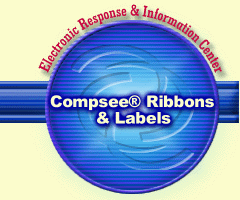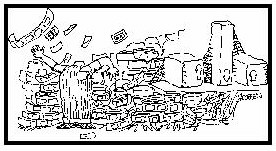
Section 1: Bar Code Printing BasicsThere are two primary activities associated with bar code systems, printing the symbols and reading them. Both are equally important even though they are separate activities, performed at different times at different locations, and many times by different companies. It is essential that these two activities be coordinated if acceptable results are to be obtained. Something must be used to make sure both activities are operating under the same rules. Of the two activities, printing and reading, the first to be performed is the printing. After all, if something is be read, it must first be available in a readable form. Someone else may be printing the bar code symbol for you, as in the case of the UPC codes printed on items in the grocery store. Or you may be printing the symbol for someone else to read, such as would be the case if you were providing a product to be resold in the grocery store. Text vs. Bar Code In our modern information age, enormous amounts of data are moved from computer to computer every day. But computers have difficulty recognizing mistakes, giving rise to the phrase "garbage in, garbage out." If you are depending upon the data to make important business decisions, it must be accurate, dependable and timely. Bar code systems are used to replace human data entry techniques because of two main attributes;
To realize the benefits offered by bar codes, their capabilities and limitations must be understood. Bar code systems are not designed to duplicate the human visual capabilities, like OCR (Optical Character Recognition) systems which require complex imaging and recognition schemes, but to replace it with components designed with readily available and low cost technology. The human visual system is capable of deciphering very complex signals. It can decipher a symbol completely illegible to the machine. But the same visual system has great difficulty in taking large quantities of simple information, such as that represented by a bar code symbol, and reducing it to a single character. On the other end of the spectrum, the limited operational range of a machine scanner dictates that it operate under a very rigid and simple set of conditions. It can process huge quantities of simple information but requires very definable elements. For example, it wants to interpret a non-reflective part of a symbol as a bar. It is very poor at deciding if what was seen was a bar or a space with some garbage in it. To compensate for this deficiency, bar code label printers are optimized for printing simple symbols such as the "bars" in a bar code. Bar code printers are designed to produce the simple character elements that can be easily read by a machine scanner. Human text fonts in contrast are designed to fit the needs of the human that is interpreting them. Humans like to see all of those curlicues and serifs hanging off the end of the characters which makes it easier for the eye to string them together into words. Machine readers are more like the engineers that designed them, they see little use in anything that does not contain information. To them perfection is found in nice straight edges and consistent spacing. A simple matrix font formed from dots is sufficient to convey the necessary information. If larger characters are needed for visibility, simply expand the size by creating larger matrix elements using multiple dots to form each element. This results in the familiar "stair-stepped" characters that were characteristic of early dot matrix printers. However, humans have become accustomed to seeing smooth and nicely rounded characters that have been printed on their modern laser printers where they have a choice of fonts with which to express their individuality. Since most labels also contain information in a human readable form, it is necessary for us to compromise somewhere. Trying to make the human readable characters pleasing to the eye comes at a price, which is paid in increased memory storage requirements and/or reduced print speed. To store a number of large matrix fonts defining a complete range of character sizes requires a lot of memory. Memory storage can be reduced if the outline font approach is employed, like that used to define TrueType or PostScript fonts. Using this implementation, only the font definition is stored and is expanded by the processor when needed, but the time required to image a label becomes longer. If items are coming down a conveyor belt at a rate of one every five seconds, a slow printer that cannot keep up is not the correct answer. Specifications Application specifications perform the coordination task between the two activities. They are used to delineate the conditions under which a bar code symbol is to be printed and read later. At a minimum, the specifications should contain the following information:
The initial step in label printing is to carefully read the specification. If no specification exists, then the first order of business is to write one. It may be a simple one page memo or a document containing many pages. No matter how simple or controlled your application, you are asking for disaster without a specification. It establishes the ground rules under which everything must operate. Even though your scanner can read the labels your present printer is producing, there is no guarantee this will be the case if you should ever replace either with different equipment, or even if you change ribbon manufacturers. Quality Considerations The implementation of a successful bar code system starts with the symbol. The code is selected based upon data requirements and the capabilities of the scanning system used. Once selected, the next step in implementing a system is to record the symbol in a manner that will ensure readability at the proper time. This is a direct measure of the QUALITY of the printed symbol. A quality symbol must not only be within specifications at the time of printing, but must remain readable throughout its life. Because the symbol is being read by a scanner, its quality level should be judged against what the scanner expects to see. Here is an example of "what you see is not necessarily what you get." The human eye may think the contrast between the bars and spaces is excellent, but if they are printed with red ink on a white background they will appear indistinguishable to a laser scanner operating in the infrared spectrum. If the bars are created by overprinting with a heavily inked ribbon on a dot matrix printer, then edge bleeding of the printed bars can result in wide spaces being interpreted by the scanner as narrow spaces. � MEASURING PRINT QUALITY Verifiers should be used with a heavy dose of common sense. Most quality printers designed for bar coding applications have few problems printing consistent symbols if they are maintained within the proper operating parameters (a good ribbon on a dot matrix printer for example). Therefore, a good sampling program can be used to maintain an acceptable quality level for most applications. Unless mandated by the customer, it is not usually necessary to verify each label as it is printed, unless your printer cannot give consistent results. If that is the case, it is time to get a better printer. What is important is whether or not the symbol can be read in the days or weeks ahead, after it has been sitting on someone's receiving dock for a couple of weeks. � QUALITY VS. TECHNOLOGY The next consideration is the base label material, which must be matched to both the print technology and the environment. If a symbol is generated by transferring ink to a label surface, then the ink must not only adhere at the time of printing, but throughout the useful life of the label. It must also provide a method of attachment to the item to be identified. This is commonly done using an adhesive-backed label material, but other methods may be used such as attachment using string or even being stapled to the item. Whatever method is used, it is critical that the label stay attached to the item. A label lying on the warehouse floor is as useless as one that cannot be read but still attached to the item. � COMPLIANCE LABELING The specification may follow the general requirements of an industry standard or may be specific to your particular customer. The customer may even level a penalty for labels that do not meet their specifications. Many follow the popular "three strikes and you are out" arrangement; the first time a label fails, you are fined, the second time one fails, you pay a larger fine, the third time one fails, they remove you from the approved vendor list. Your customer will undoubtedly institute some type of quality check on incoming labels. This can be as simple as scanning them to see if they read correctly or they may take a statistical sampling of the labels and use a bar code verifier to test them. Obviously you would like to catch any bad labels before they leave your shipping dock! Now is the time to create your own quality assurance program to make sure you are consistently producing labels to your customer's specifications. The quality assurance program should mirror that of your customer, so that when problems do occur (and they will occur), you are comparing apples to apples and can immediately identify and correct the problem. It may be that the incorrect ribbons or label stock was purchased. Or that preventive maintenance procedures were not followed, allowing the print quality to degrade.
An on-line verifier system (one that checks each bar code as it is printed and interrupts the printing if an out of spec symbol is detected) may be needed if strict quality control measures are required. For less stringent requirements, a statistical sampling with a hand-held verifier may be all that is needed. Demand vs. Batch Printing? � BATCH PRINTING
�DEMAND PRINTING Printing labels only when they are required has many advantages. It is also more restrictive on how the labels are produced. Demand printers can operate in the real time production environment. They accept data from the system and produce a label with data unique to that particular article. The variable data can be almost anything; serial numbers, sequence codes, test results, date codes, lot codes, etc. Because the labels are printed on the spot and usually one at a time, the type of printer needed has to meet a number of special requirements that do not apply to batch printing.
The applications for which demand label printers are used can be categorized by the following:
Copyright � 1998 |
top
Home | The Company | Systems Solutions | Products & Pricing
Software & Support | Reseller Resources | Contact Compsee
